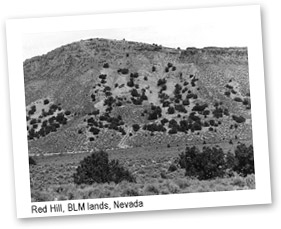|
Online exhibits : Special exhibits : Fossils in our parklands
Bureau of Land Management: Red Hill, Nevada
by Brian Swartz
The Red Hill locality, in Eureka County at the northern end of the Simpson Park Mountains, is on lands administered by the Bureau of Land Management, an agency of the United States Department of the Interior. The fauna and geology indicate that the field site, known as Red Hill I, was a marine environment during the Middle to Late Devonian. Cnidarians such as conulariids, a group that is known elsewhere only from marine strata, are preserved in most levels of the Red Hill site, along with sponges, gastropods, ammonoids, articulate and inarticulate brachiopods, echinoderms, gnathostomes (jawed fish), and plants. The widespread deposition of limestone and shale suggests that the regional geology of the northern Simpson Park Range is of an open marine paleoenvironment, in particular, the outer continental shelf. By contrast, the presence of trace fossils in the upper-most beds indicates a nearshore environment. Important vertebrates preserved at the site include the first stem-tetrapod from the Middle Devonian of western North America. |
UCMP involvement
The site was discovered by Mike Murphy at the University of California, Riverside, and excavated by UCMP paleontologists Joseph Gregory and his graduate students during the late 1970s-early 1980s. Brian Swartz, a current UCMP graduate student, is describing the stem-tetrapod material collected during those expeditions.
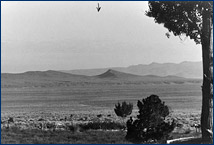 |
 |
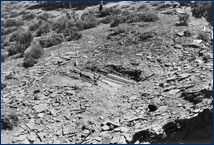 |
 |
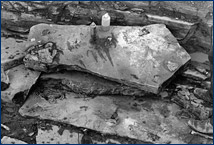 |
 |
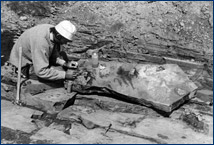 |
 |
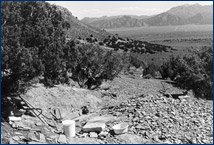 |
 |
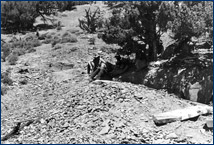 |

Click on any of these images to see enlargements. These are photos taken by Joe Gregory during field work at Red Hill in July of 1974. Gregory wrote brief descriptions on the backs of his photos. Top left: "Red Hill from Willow Creek Ranch, Nevada." Top middle: "Layers uncovered, before excavation. 'Ted Menke's quarry.'" Top right: "Crossopterygian fish in layer 8." Bottom left: "John Reed papering large fish skull." Bottom middle: "Upper block with large fish removed from quarry and skull protected by plaster jacket." Bottom right: "The two slabs with large crossopterygian awaiting transportation." |
The origin of terrestrial vertebrates represents one of the major evolutionary and ecological transitions in the history of life and involved modifications and innovations in almost every biological system. The discovery and description of a well-preserved fossil tetrapod "precursor" (fleshy-limbed vertebrate) from this field site fills in some of these details and helps to further resolve the sequence of changes that underpin the tetrapod condition.
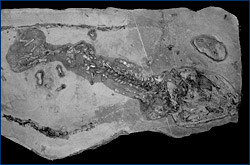 |
 |
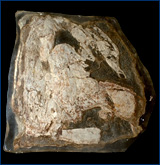 |
 |
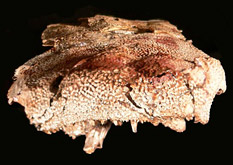 |

Three of six stem-tetrapod specimens identified in the collections from Red Hill. Left: This skeleton is about three feet long. Middle: This skull, that measures about one foot from front to back, is the large "crossopterygian skull" that is shown being excavated in the photos above. Right: A stem-tetrapod snout, about four inches across, with a nostril visible at the front left. |
In the collections
UCMP houses numerous Devonian fish fossils from field sites from Red Hill; 284 specimens are currently in the UCMP online database (do a search).
Note: Collection of vertebrate fossil material is illegal unless done under a permit from the Bureau of Land Management. If you think you have found a vertebrate fossil on BLM lands, please contact a BLM representative.
More information
Arratia, G., and R. Cloutier. 2004. A new cheirolepidid fish from the Middle-Upper Devonian of Red Hill, Nevada, USA. Pp. 583-598 in G. Arratia, M.V.H. Wilson, and R. Cloutier (eds.), Recent Advances in the Origin and Radiation of Vertebrates. Verlag Dr. Friedrich Pfeil, München, Germany. (pdf)
Gregory, J.T., T.G. Morgan, and J.W. Reed. 1977. Devonian fishes in central Nevada. Pp. 112-120 in M.A. Murphy, W.B.N. Berry, and C.A. Sandberg (eds.), Western North America: Devonian. University of California, Riverside Campus Museum Contributions 4.
Murphy, M.A., T. Morgan, and D.L. Dineley. 1976. Astrolepis sp. from the Upper Devonian of central Nevada. Journal of Paleontology 50(3):467-471.
Reed, J.W. 1985. Devonian dipnoans from Red Hill, Nevada. Journal of Paleontology 59(5):1181-1193.
Reed, J. W. 1992. The actinopterygian Cheirolepis from the Devonian of Red Hill, Nevada, and its implications for acanthodian-actinopterygian relationships. Pp. 243-250 in E. Mark-Kurik (ed.), Fossil Fishes as Living Animals. Academy of Sciences of Estonia, Tallinn.
Reed, J.W. 1986. The acanthodian genera Machaeracanthus and Persacanthus from the Devonian of Red Hill, Nevada. Geobios 19(4):409-419. DOI: 10.1016/S0016-6995(86)80001-8
Schultze, H.-P. 2010. The late Middle Devonian fauna of Red Hill I, Nevada, and its paleobiogeographic implications. Fossil Record 13(2):285-295. DOI: 10.1002/mmng.201000001
